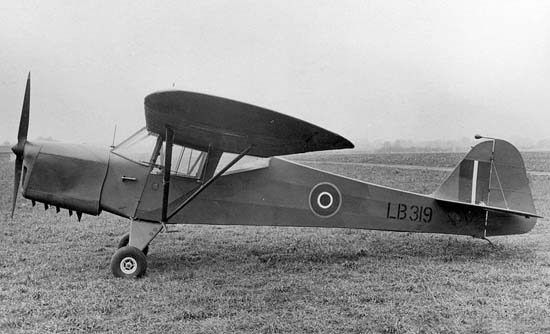BRITISH AVIATION RESOURCE CENTER > TRANSPORT/UTILITY > PREVIOUS PAGE

Auster III.
|
Type: Liaison aircraft Origin: Taylorcraft Aeroplanes (England) Ltd Models: Auster Mk. I-V Crew: 1-3 First Flight: N/A Service Delivery: 1942 Production Termination: N/A Number Produced: 1,630 POWERPLANT: Model: O-290-3 Manufacturer: Lycoming Type: flat-four piston Number: One Horsepower: 130 hp Dimensions: Wing span: 36 ft 0 in (10.97 m) Length: 22 ft 5 in (6.83 m) Height: 8 ft 0 in (2.44 m) Wing Surface Area: 167 ft² (15.51 m²) |
Weights: Empty: 1,100 lb (499 kg) Max. Loaded: 1,850 lb (839 kg) Performance: Maximum Speed: 130 mph (209 km/h) Cruising Speed: N/A Stall Speed: N/A Climb to 6,000 ft: N/A Service Ceiling: N/A Wing loading: N/A Range: 250 miles (402 km) Armament: None |
The Taylorcraft Auster was a British military liaison and observation aircraft produced by the Taylorcraft Aeroplanes (England) Limited company during the Second World War.
Design/Development:
The Auster was a twice removed development of an American Taylorcraft design of civilian aircraft, the Model A. The Model A had to be redesigned in Britain to meet more stringent Civil Aviation standards and was named the Taylorcraft Plus C. After the start of the Second World War, the company developed the model further as an Air Observation Post (AOP)—used for directing artillery fire—aircraft for working with the British Army Royal Artillery units.
The Plus C was re-engined with the Blackburn Cirrus Minor I engine and re-designated the Taylorcraft Plus D. Most of the civil Plus Cs and Ds were impressed into Royal Air Force service, the Plus Cs were re-engined with the Cirrus Minor I and re-designated as Plus C2.
The first Auster I was the eleventh Taylorcraft Plus C aircraft which was delivered to the Air Ministry for trials in 1939. The trials led to an order for 100 aircraft placed in 1941.
The Auster II was a re-engined aircraft with an American 130 hp (97 kW) Lycoming O-290 engine. Due to the shortage of American engines that version was not built but led to the Auster III (Model E), which was the same as the Auster I but had a 130 hp (97 kW) de Havilland Gipsy Major engine. The next development was the Auster IV (Model G) which had a slightly larger cabin with three seats and used the Lycoming O-290. The major production version was the Auster V (Model J) which was an Auster IV with blind flying instruments, and a flap modification.
Post war the Auster Mark V was used as the basis for the Auster J/1 Autocrat intended for the civilian market; the British firm having changed their name to Auster and stopped licensing from Taylorcraft. Further military aircraft were supplied post war; the Auster AOP6, Auster T7 (a trainer), and the Auster AOP9.
Operational history
The Auster Mark III, IV and V were issued to fifteen Royal Air Force (RAF) Air Observation Post (AOP) Squadrons. Four of them (Nos. 651, 654, 655 and No. 657) fought since 1943 in North Africa and Italy, being joined from August 1944 by No. 663 Polish squadron. The other seven squadrons (Nos. 652, 653, 658, 659, 660, 661 and No. 662) operated after D-day in France and then the Low Countries. No. 664 Squadron RCAF, No. 665 Squadron RCAF, and No. 666 Squadron RCAF were also issued with the Auster Mk. IV and V, formed in the UK at RAF Andover in late 1944 and early 1945. The RCAF squadrons were manned by Canadian personnel of the Royal Canadian Artillery and the Royal Canadian Air Force, with brief secondment to the squadrons with pilots from the Royal Artillery; overall control was maintained in the UK by 70 Group, RAF Fighter Command. The three squadrons deployed from RAF Andover, England, to the Netherlands, to Dunkirk, France, where the last Canadian 'shots' in Europe were fired, and
later to occupied Germany. No. 656 Squadron RAF used Austers within the South East Asia Command (SEAC) in Burma/India theatre.
The Royal Australian Air Force's No. 16 AOP Flight and No. 17 AOP Flight operated Auster Mark III aircraft in support of the Australian Army in the Pacific Theatre from October 1944 until the end of the war.
Several AOP squadrons were reformed within the Royal Auxiliary Air Force in 1949 and these operated some AOP.5s, AOP.6s and AOP.9s until at least March 1957, when the Auxiliary Air Force was disbanded. Some Auster AOP units were taken up into the Army Air Corps when it was formed in September 1957.
The air observation duties, insurgency and casualty evacuation roles performed by Auster and similar light aircraft were generally taken over by light helicopters from the mid 1960s.
Variants:
| Plus C | Original civilian version with a Lycoming 0-145-A2 engine, 23 built. | |
| Plus C2 | Plus C re-engined with a 90hp Cirrus Minor I engine for the Royal Air Force, 20 conversions. | |
| Plus D | Plus C with a 90hp Cirrus Minor I engine, 9 built. | |
| Auster I | Military version of Plus C, 1 conversion and 100 built. | |
| Auster II | Auster I with a Lycoming 0-290 engine, 2 built. | |
| Auster III | Auster I with a de Havilland Gipsy Major engine, 470 built. | |
| Auster IV | Three-seat version with a Lycoming 0-290-3/1 H.O. engine, 255 built. | |
| Auster V | Auster IV with blind flying instruments (Vacuum pump) and flap modification, and removable armour plate installed for pilot only, 790 built. |
Sources:
Wikipedia
BRITISH AVIATION RESOURCE CENTER > TRANSPORT/UTILITY > PREVIOUS PAGE
